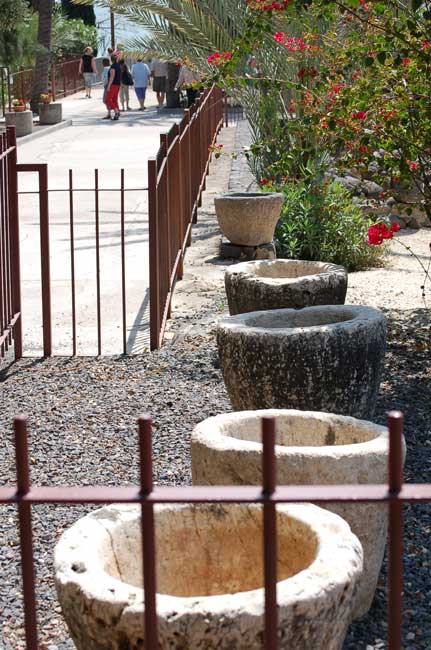
ISRAEL PHOTOS IV -- Pilgrimage |
John 2 (WEB)
1 The third day, there was a marriage in Cana of Galilee. Jesus’ mother was there. 2 Jesus also was invited, with his disciples, to the marriage.
3 When the wine ran out, Jesus’ mother said to him, “They have no wine.” 4 Jesus said to her, “Woman, what does that have to do with you and me?
My hour has not yet come.” 5 His mother said to the servants, “Whatever he says to you, do it.” 6 Now there were six water pots of stone set there after
the Jews’ way of purifying, containing two or three metretes[a] apiece. 7 Jesus said to them, “Fill the water pots with water.” They filled them up to
the brim. 8 He said to them, “Now draw some out, and take it to the ruler of the feast.” So they took it. 9 When the ruler of the feast tasted the
water now become wine, and didn’t know where it came from (but the servants who had drawn the water knew), the ruler of the feast called the
bridegroom, 10 and said to him, “Everyone serves the good wine first, and when the guests have drunk freely, then that which is worse. You have kept
the good wine until now!”
Alcoholism is a leading cause of cancer, pancreatitis, early onset dementia and other evils. Some studies have shown drinking one glass of wine a day increases a person's life span.
In 1905 the German Oriental Society uncovered three stone water jars while excavating the 2nd-3rd century White Synagogue at Capernaum. There are currently five stone water jars on display.

Roman era Talmudic Jews had numerous laws to avoid the ritual uncleanness caused by a woman's menstrual cycle, other bodily emissions, touching human corpses, touching corpses of unclean animals, or touching objects that had been in contact with unclean objects. The superstition required numerous observances, quarantine, and immersion after uncleanness. Red heifer ashes and dipping in unsanitized community pools were traditional remedies against uncleanness. Almost any object could be made unclean, yet stone was not singled out as an example of an unclean substance; thus it had been thought of as being clean. People stored water in stone jars as they thought this would keep it clean
Those who handled the Hebrew scrolls in the synagogue service needed to wash their hands before lifting the scrolls. These stone water jars may have been used to facilitate the service as they stored large quantities of clean water. A circa first century limestone water jar was turned on a lathe. Numerous elaborate stone water jars were also found in the ruins of the homes of the wealthy on the western hill of Jerusalem, opposite the Herodian temple.
Stone Water Jars were also found at Caesarea Philippi
First century stone water jars are on display in the Burnt House Museum in Israel. Jerusalem was destroyed by the Romans c.
70 AD and the stone water jars were from the ruins of a house destroyed at this time. There are also limestone water jars on display at
the Wohl Museum in the Old City section of Jerusalem.
Nazareth Synagogue
Churches of the Annunciation
Latin Tradition -- Mount of
Precipitation
Nazareth Aerial View
Museum of the Basilica
Hot Springs at Tiberias
Stone Water Jars at Capernaum
Capernaum
Tabgha
Bethsaida
A 1909 Galilee Fishing Description
The Giant Mustard Plant
Kursi and the Gadarene Demoniac
Jar of Ointment
Cana
Wheat and Tares